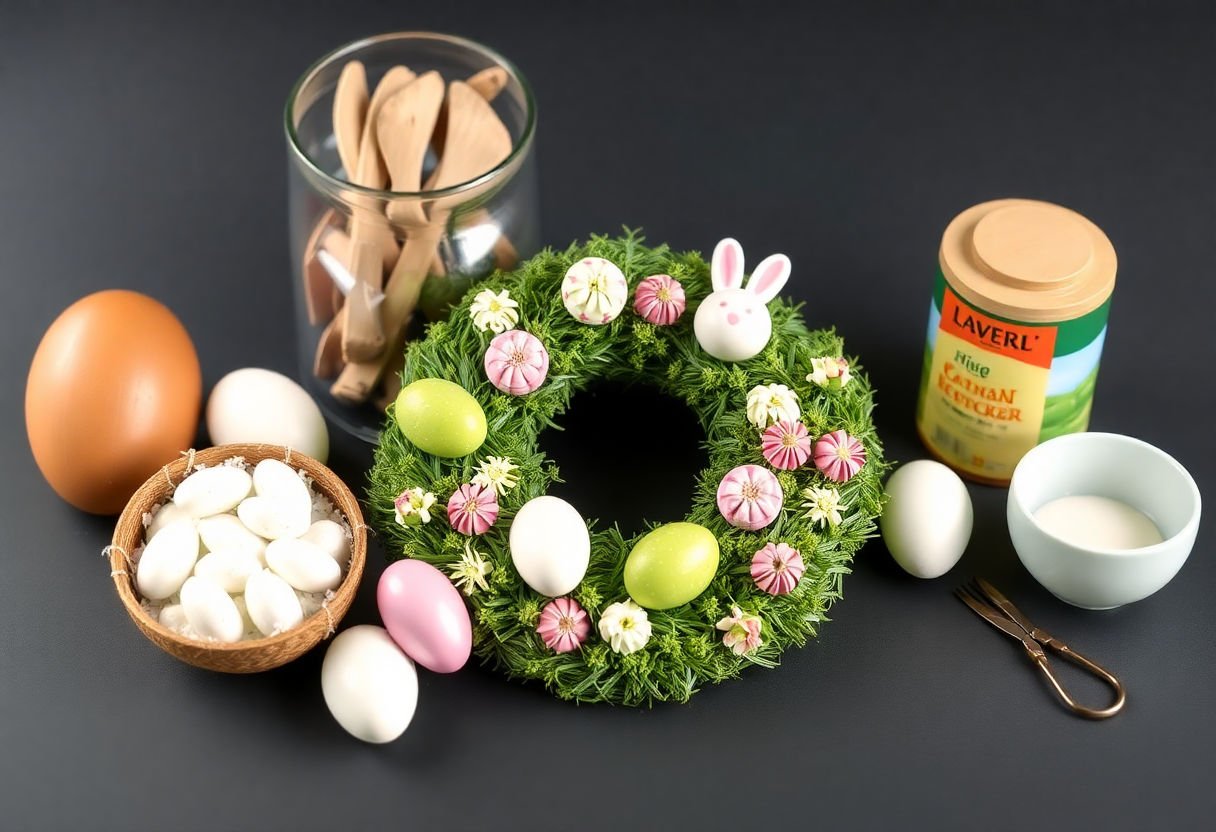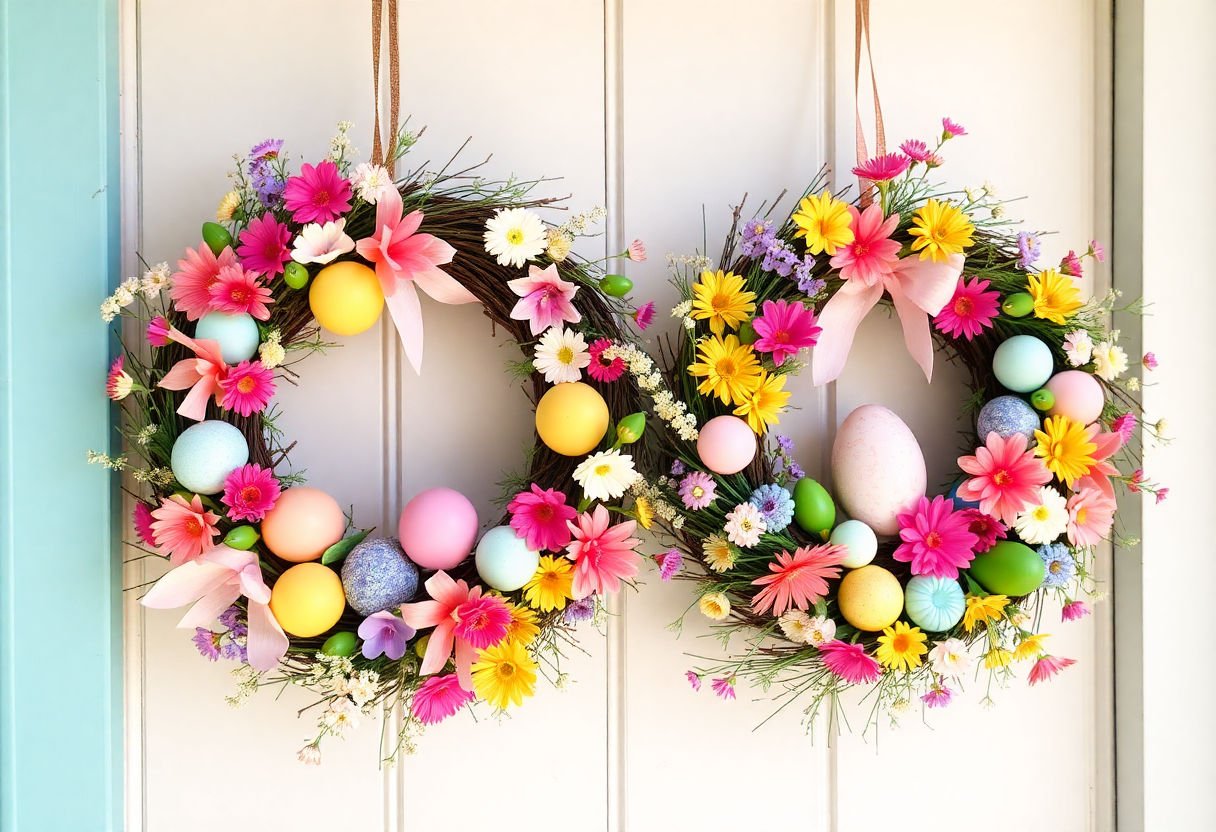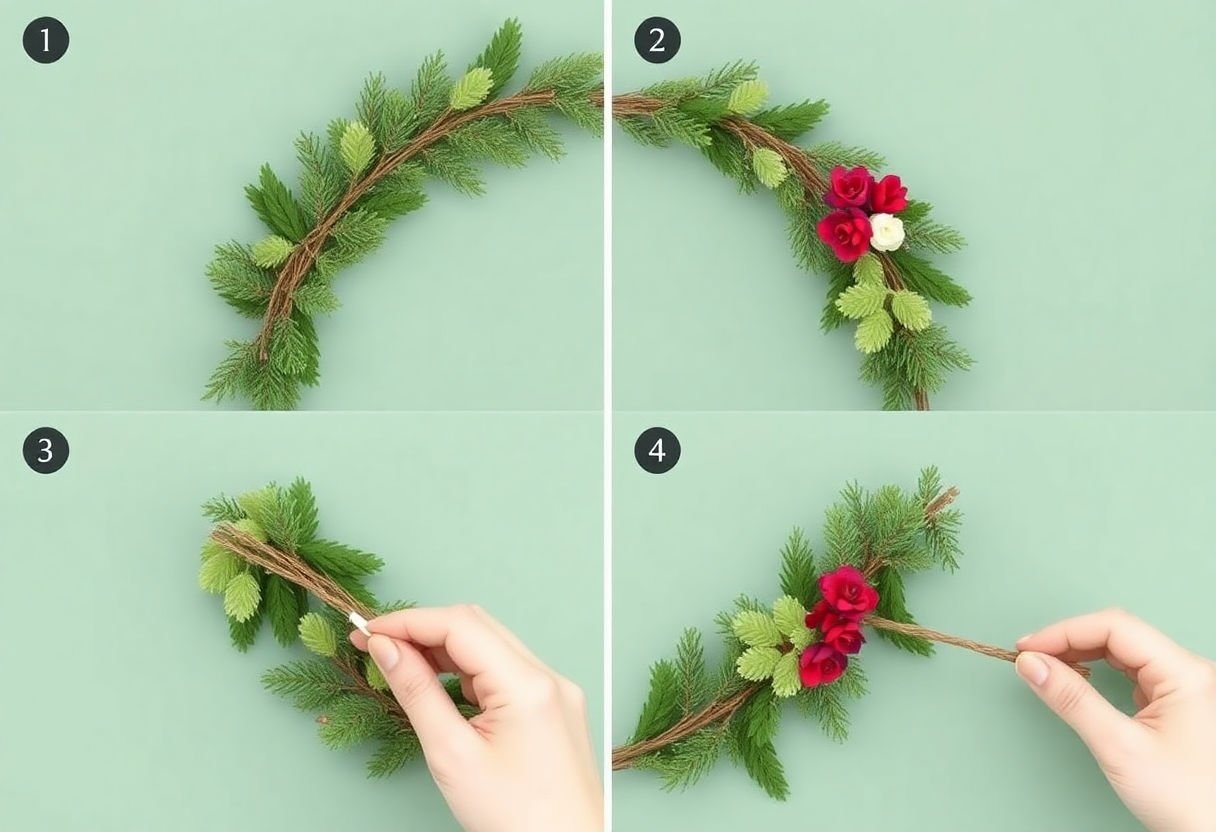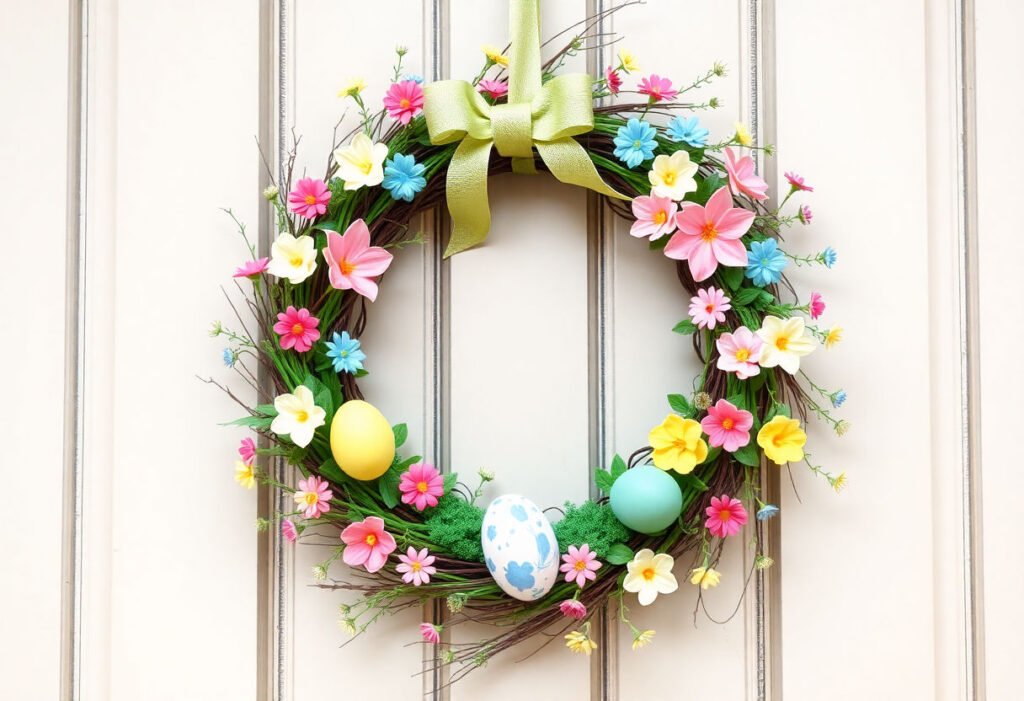Discover the joy of crafting your own Easter wreaths to add a personal touch to your holiday decorations. This guide will walk you through the essentials of creating stunning wreaths using simple DIY techniques. By gathering necessary materials, learning step-by-step crafting methods, and exploring creative personalization ideas, you’ll be equipped to design beautiful wreaths that reflect your unique style. Whether you aim to enhance your decor with ribbons, flowers, or other charming embellishments, or avoid common crafting pitfalls, this comprehensive guide provides everything you need to make Easter wreaths that are both festive and uniquely yours.
Key Takeaways
- Gather the essential materials needed for Easter wreath crafting, ensuring a foundation for creativeness and durability.
- Learn step-by-step techniques to create unique and stunning wreaths that stand out during the Easter season.
- Explore a variety of creative ideas and inspirations to personalize your wreaths, making them a reflection of your style.
- Avoid common mistakes in wreath crafting to ensure your project meets your expectations and decor standards.
- Gain inspiration from diverse Easter wreath designs to fuel your creativity and enhance your holiday decorations.
Choosing the Right Materials

When crafting stunning Easter wreaths with your own flair, selecting the right materials is paramount. Essential materials include wreath bases, decorative pieces, and basic tools, each serving a unique purpose in your creation.
Start with the wreath base; a sturdy foundation ensures your decorations stay secure. Consider options like:
- Styrofoam: Lightweight and easy to work with, ideal for indoor wreaths.
- Grapevine: Offers a natural, rustic look, perfect for outdoor displays.
- Wire frames: Provide robust support, versatile with various decorations.
Next, choose decorative elements to bring your Easter theme to life. Common choices include:
- Artificial flowers: Available in a wide range of colors and types, these add a vibrant touch.
- Easter eggs: Use plastic or wooden eggs painted in pastel or bright hues.
- Ribbon and bows: Opt for satin or burlap to complement the wreath’s theme.
Additional embellishments like ** faux grass**, moss, and butterflies can enhance the visual appeal, adding layers of interest and texture.
Tools play an integral role in your assembly process. Some must-have tools are:
- Hot glue gun: Essential for attaching heavier decorations securely.
- Wire cutters/scissors: Use these to trim floral stems, ribbons, and wires.
- Floral wire: Useful for fastening items together and shaping the wreath.
Choosing the right combination of materials can elevate your Easter wreath from ordinary to extraordinary, reflecting both seasonal charm and your unique style.
Designing Your Wreath
Crafting a memorable Easter wreath begins with a thoughtful design plan that aligns with your personal style and home decor. Whether you favor a traditional look or something more contemporary and artistic, the design of your wreath can reflect your unique flair and ethos.
A variety of design styles exist to cater to diverse tastes. For those who cherish classic elegance, consider weaving lush greenery with pastel-colored flowers like tulips or daffodils. These elements not only capture the essence of spring but also imbue your wreath with a subtle yet sophisticated charm.
For a more modern touch, incorporation of geometric shapes can add an avant-garde dimension. Utilize metallic wires or frames to construct sleek, eye-catching designs. Pairing these with bold, single-hued flowers or minimalist adornments such as feathers can create a striking visual contrast.
Patterns play a crucial role in enhancing the aesthetic appeal of your wreath. Stripes, zigzags, or polka dots can be achieved using ribbons or painted eggs to achieve a fun and festive look. These playful patterns breathe life into the wreath, making it a perfect centerpiece for your Easter decorations.
Color schemes should be contemplated with intention; a harmonious palette connects your wreath to the season. Pastel hues are customary for Easter, embodying the vibrant renewal of nature. However, don’t shy away from adding hints of vivid colors like fuchsia or emerald for an unexpected pop that highlights your creativity and personal design narrative.
Ultimately, your wreath should be a reflection of your imagination and joy, resonating with your personal interpretation of Easter celebration.
Decorative Elements to Consider

To craft a truly captivating Easter wreath, selecting the right decorative elements is crucial. These elements not only enhance the visual appeal but also bring a touch of personal charm to your creation.
Ribbons are versatile and add a splash of color and texture. Opt for pastel shades or floral patterns that resonate with Easter’s springtime feel. They can be gracefully tied into bows or wound around the wreath base to create layers of elegance.
Flowers are quintessential to Easter decor. Choose from a mix of real or artificial blooms, like tulips, daffodils, or lilies, to infuse a natural vibrancy. Arrange them in clusters or sporadically for a more organic look. Consider using silk flowers for a long-lasting wreath that can be used year after year.
No Easter wreath is complete without eggs, representing new life and rebirth. Incorporate small, decorative Easter eggs made from wood, plastic, or foam. They can be painted in soft hues or decorated with intricate designs.
Greens and Foliage bring an earthy stability to the wreath. Eucalyptus, ivy, or even faux grass can fill gaps and provide a lush background for other decorations.
Add a whimsical touch with seasonal accouterments like bunny figurines or small chick ornaments. These elements, though subtle, can make your wreath uniquely festive.
Finally, don’t shy away from personal mementos. A family heirloom or a personal trinket can serve as a focal point, imparting a sentimental value that turns your wreath into a cherished piece of art.
Step-by-Step Guide to Creating a Basic Wreath

To start your journey of crafting a basic Easter wreath, begin by gathering your materials. You will need a wreath base, which can be made of foam, wire, or grapevine. This serves as the structure around which your decorations will be arranged. Choose one that suits your design preference and is sturdy enough to hold your decorative elements.
Next, select the decorative elements. Common choices include faux flowers like daffodils and tulips, which evoke the essence of spring. If you prefer a more natural look, consider using fresh blooms or greenery. Additionally, incorporate elements such as pastel-colored eggs, butterflies, or small birds to enhance the festive theme. Ribbons in complementary colors can add an elegant finishing touch.
Begin the assembly process by securely attaching the primary elements to the wreath base. Use floral wire or a hot glue gun for this task; make sure everything is firmly in place. Start by adding the larger elements initially, followed by the smaller ones to keep the design balanced. Use wire to attach the stems of flowers directly to the wreath form.
Once the major elements are in place, fill in any gaps with smaller decorations like leaves or berries. This helps in maintaining visual interest and texture throughout the wreath. Finally, tie a ribbon at the top or bottom, ensuring it hangs gracefully.
Remember to periodically step back and review your progress, allowing adjustments to ensure symmetry and balance. This step-by-step approach ensures that your Easter wreath becomes a stunning centerpiece for your holiday decorations.
Adding Personal Flair
Personalizing your Easter wreath offers an exciting opportunity to showcase your creativity. By adding unique elements, you can craft a wreath that truly reflects your style and personal flair. Consider the following ideas to elevate your wreath making experience:
-
Incorporate Family Heirlooms: Integrating small, meaningful items such as vintage brooches, buttons, or even small family photographs can create a nostalgic and personalized touch. These elements not only add character but also tell a story, making your wreath a cherished piece of decor.
-
Seasonal Substitutes: While traditional Easter wreaths often feature pastel colors and spring motifs, consider modifying the palette to suit your home’s interior decor. Use deep earth tones or vibrant hues if they complement your existing decor better, adding sophistication and uniqueness without losing the essence of the season.
-
Personalized Signs and Messages: Include small chalkboards or wood-burned plaques with personalized messages or the family name to add a welcoming and intimate feel. Such signs can be easily updated with new messages each year, keeping your wreath fresh and relevant.
-
Experiment with Textures: Combining different textures can make your wreath stand out. Mix in natural elements like burlap, felt, or twine alongside traditional materials. Such contrasts can elevate the overall appearance, adding depth and visual interest.
By thoughtfully incorporating these elements, you can ensure that your Easter wreath not only captures the festive spirit but also becomes a distinctive piece that embodies your personal style and festive enthusiasm.
Common Mistakes to Avoid

Crafting stunning Easter wreaths is an enjoyable endeavor, yet certain common pitfalls can inadvertently diminish the desired impact. Ensuring your wreath project unfolds beautifully requires attention to detail and awareness of potential errors.
First and foremost, improper material selection impacts the wreath’s longevity and visual appeal. It’s crucial to choose materials suited to the intended setting of your wreath. For outdoor wreaths, opt for weather-resistant decorations to withstand the elements.
Another frequent mistake is overcrowding the wreath. While it’s tempting to adorn your creation with multiple elements, this can result in a cluttered appearance. Instead, prioritize a carefully curated selection of decorative pieces, balancing size and color harmoniously.
Neglecting balance and symmetry is another issue that can deter from your wreath’s elegance. An uneven distribution of embellishments can create an awkward, lopsided look. Always step back periodically to assess and adjust, ensuring even spacing and distribution.
Inadequate adhesion of elements poses a significant risk. If decorations aren’t securely attached, they may become dislodged over time. Use robust adhesives appropriate for your chosen materials, ensuring all pieces remain intact.
Lastly, overlooking the importance of personalization results in a lack of distinctive character. While crafting, infuse your wreath with unique details that reflect your personal style. Integrating unexpected elements or thematic accents can transform a simple wreath into a remarkable display.
By recognizing and avoiding these common missteps, you will be better equipped to create a masterpiece that enhances your Easter festivities with style and grace.
Inspiration for Easter Wreath Designs
Unleashing your creativity with Easter wreaths can be both satisfying and rewarding. Here are some inspiring ideas to help you design a wreath that captures the essence and joy of the Easter season:
-
Botanical Bliss: For a more natural look, consider using greenery such as eucalyptus, ivy, or ferns. These can be accentuated with soft pastel flowers like tulips or daffodils. The beauty of botanical elements lies in their ability to convey a serene and inviting atmosphere.
-
Rustic Charm: Embrace the rustic aesthetic by incorporating burlap ribbons, wooden accents, and moss. Adorn your wreath with wooden or chalk-painted Easter eggs for a countryside feel that is both quaint and charming. This design works beautifully for homes with vintage or farmhouse decor.
-
Vibrant Vibes: Infuse your wreath with bright and bold colors to represent the happiness of Easter. Use vivid silk flowers, neon ribbons, and brightly painted eggs to create an eye-catching display. This is perfect for those who enjoy making a statement with their festive decor.
-
Minimalist Elegance: Opt for simplicity with a minimalist design that employs neutral tones and clean lines. A simple grapevine wreath adorned with a few carefully selected white or pastel blooms, complemented with a satin ribbon, exudes understated sophistication.
-
Traditional Easter Icons: Incorporate traditional symbols such as the Easter bunny, chicks, or crosses. Craft these using felt, foam, or fabric to add dimension and interest. These timeless elements can evoke a sense of nostalgia and reverence.
As you embark on creating your Easter wreath, remember that the best designs often emerge from personalized touches and a reflection of your unique style.
Conclusion
Creating stunning Easter wreaths with a DIY flair not only adds a personal touch to your holiday decorations but also offers a rewarding creative outlet. By carefully selecting materials and incorporating unique decorative elements, you can craft visually appealing and personalized wreaths that reflect your style. As you explore various design inspirations and avoid common crafting mistakes, remember that each wreath is an opportunity for experimentation and expression. Embrace your creativity, and let each project ignite new ideas for future seasonal decorations. With these skills, every Easter offers a fresh canvas for your evolving artistic journey.
Frequently Asked Questions
How can I ensure my Easter wreath lasts throughout the season?
To enhance the longevity of your Easter wreath, it is essential to keep it in a dry, cool location, away from direct sunlight and moisture. Additionally, using a clear protective spray can help preserve the wreath’s elements.
What supplies should I invest in for making quality wreaths?
Investing in quality wreath bases, hot glue guns, and a variety of decorative elements like ribbons and artificial flowers will provide the best foundation for creating durable and beautiful wreaths.
Can I use natural elements in my DIY Easter wreath?
Yes, incorporating natural elements such as dried flowers and twigs can add a rustic charm to your wreath. However, ensure they are properly dried to prevent mold or decay.
How do I store my wreath after the Easter season?
To store your wreath, place it in a sturdy box with ample padding, such as bubble wrap, to protect it from damage. Store the box in a cool, dry place to maintain the wreath’s condition.
Are there any specific themes that work well for Easter wreaths?
Popular themes include pastel colors, spring blooms, and traditional Easter symbols like eggs and bunnies. These elements can be combined to reflect both personal taste and traditional motifs.


